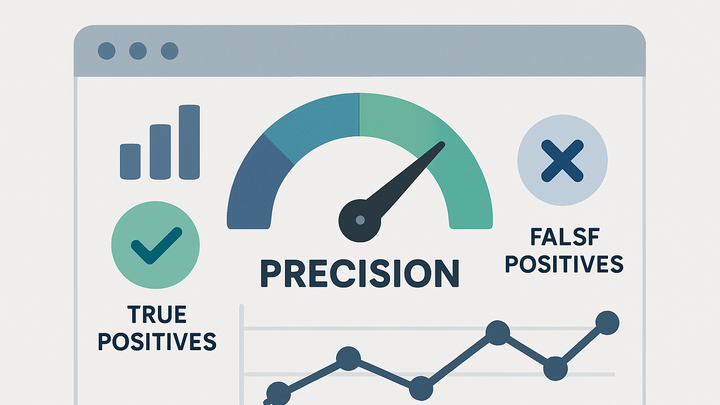Published on 2025-06-28T04:00:23Z
What is Precision in Analytics?
In analytics, Precision measures the proportion of correctly identified positive events against all events flagged as positive. It helps analysts understand the reliability of their tracking setup by highlighting the rate of false alarms (false positives). High precision indicates that most events recorded truly match the criteria defined, ensuring insights and decisions are based on accurate data.
Unlike recall, which focuses on capturing all relevant events, precision emphasizes the correctness of what is captured, reducing noise and improving data quality. Precision is especially vital in scenarios where false positives can lead to misguided marketing decisions or resource misallocation. Tools like GA4 and PlainSignal enable teams to configure, measure, and optimize precision through event validation, filtering, and monitoring.
Precision
Precision is the ratio of true positives to all flagged positives, measuring the accuracy of event tracking by minimizing false positives.
Definition and Importance
This section explores what precision measures in analytics and why it is a critical metric for evaluating data quality. Precision focuses on the correctness of captured events by comparing true positives to false positives.
-
What precision measures
Precision calculates the proportion of true positives (correctly identified events) against all positive classifications (true positives + false positives). It quantifies the reliability of event tracking.
-
True positive
An event that matches the defined criteria and is correctly captured.
-
False positive
An event that does not match the criteria but is incorrectly recorded as such.
-
-
Why precision matters
High precision reduces noise from incorrect data, leading to more trustworthy insights and better decision-making. It is especially vital when false alarms carry significant costs.
How to Calculate Precision
Precision is computed using a simple formula, but interpreting its value requires context. This section covers both the calculation and how to derive insights from its results.
-
Formula
Use the formula: Precision = True Positives / (True Positives + False Positives). Expressed as a decimal or percentage.
-
Interpreting results
A precision of 1 (or 100%) means no false positives; a lower precision indicates a higher rate of incorrect event captures. Balance precision with recall based on your analytics goals.
Practical Examples with GA4 and PlainSignal
Learn how to apply precision concepts in two popular analytics platforms: Google Analytics 4 and PlainSignal. Each example highlights setup, monitoring, and how precision affects data quality.
-
Google analytics 4 (GA4)
In GA4, configure conversion events with clear parameters and use DebugView to validate true positives. Regularly audit reports to check for unexpected spikes that may indicate false positives.
-
Setting up events
Define event parameters that precisely match user actions, such as
purchase_valueorform_submit, to reduce ambiguity. -
Using debugview
Monitor real-time events in DebugView to verify each captured event aligns with your criteria.
-
-
PlainSignal cookie-free analytics
PlainSignal offers a privacy-first, cookie-less approach. Use the provided tracking code to capture events while maintaining high precision.
-
Tracking code setup
Insert the PlainSignal script into your site header:
<link rel="preconnect" href="//eu.plainsignal.com/" crossorigin /> <script defer data-do="yourwebsitedomain.com" data-id="0GQV1xmtzQQ" data-api="//eu.plainsignal.com" src="//cdn.plainsignal.com/plainsignal-min.js"></script> -
Verifying events
Use the PlainSignal dashboard to inspect captured events and compare them against your expected metrics, ensuring minimal false positives.
-
Strategies to Improve Precision
Enhance the precision of your analytics setup with targeted strategies. Focus on validation, filtering, and ongoing monitoring to maintain high data quality.
-
Data validation rules
Implement front-end and back-end checks to ensure only valid events are sent to your analytics service. Validate event schema and types.
-
Segmentation and filtering
Use segmentation to isolate relevant user groups and apply filters to exclude bot traffic or test environments, reducing false positives.
-
Regular audits and qa
Schedule periodic reviews of event definitions and sampling settings. Conduct QA tests after deployments to catch tracking errors early.
